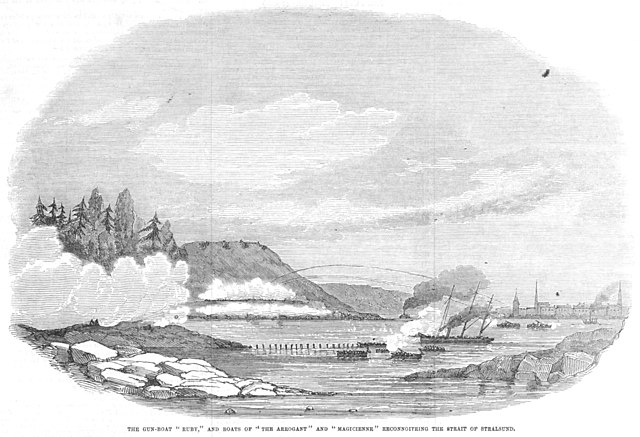Top Qs
Timeline
Chat
Perspective
HMS Magicienne (1849)
Frigate of the Royal Navy From Wikipedia, the free encyclopedia
Remove ads
HMS Magicienne was the lead ship of her class of two 16-gun, steam-powered second-class paddle frigates built for the Royal Navy in the 1850s. Commissioned in 1853 she played a small role in the Crimean War of 1854–1855 and was sold for scrap in 1866.
Remove ads
Design and construction
Summarize
Perspective
The Magicienne-class ships had a length at the gun deck of 210 feet (64 m) and 185 feet 6 inches (56.5 m) at the keel. They had a beam of 36 feet (11 m), and a depth of hold of 24 feet 6 inches (7.5 m). Magicienne's tonnage was 1,25812⁄94 tons burthen and she had a draught of 8 feet 4 inches (2.5 m). Their crew numbered 175 officers and ratings.[1]
The ships were fitted with a pair of 2-cylinder oscillating steam engines, rated at 400 nominal horsepower, that drove their paddlewheels. The engines produced 1,300 indicated horsepower (970 kW) in service that gave them speeds of 9–10 knots (17–19 km/h; 10–12 mph). The ships were armed with eight 32-pounder (56 cwt)[Note 1] cannon on the gundeck. On the upper deck were one each 68-pounder (95 cwt) and a 10-inch (254 mm) (85 cwt) shell guns as well as four more 32-pounders.[2]
Magicienne and her sister ship Valorous were originally ordered on 25 April 1847 as first-class sloops to John Edye's design, approved on 12 August 1847. On 5 August they were re-ordered as 210 ft (64 m) vessels. When completed, they constituted the last group of paddle warships built for the Royal Navy.[1]
Remove ads
Career
Magicienne was laid down at Pembroke Dockyard in September 1847, launched on 7 March 1849 and completed on 20 February 1853.

The ship was sent to the Baltic Sea during the Crimean War.

She was sold for scrap to Marshall of Plymouth in September 1866.[1]
Remove ads
Notes
- "Cwt" is the abbreviation for hundredweight, 56 cwt referring to the weight of the gun.
Citations
References
External links
Wikiwand - on
Seamless Wikipedia browsing. On steroids.
Remove ads

